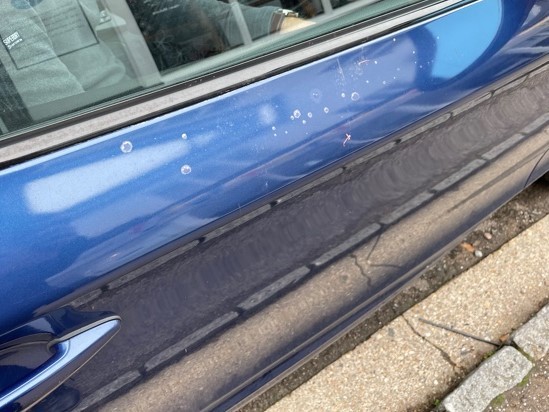Lacquer peel, also known as clear coat failure, is a common cosmetic issue that can affect the appearance and value of your car. It occurs when the clear top layer of your car’s paint begins to separate from the base coat, leading to a flaky, unsightly finish. If you’re dealing with peeling lacquer, you might be wondering how to tackle this problem. This guide will walk you through the causes of lacquer peel and explore both DIY and professional repair options to restore your car’s paintwork.
Understanding Lacquer Peel: Causes and Why It Matters
Lacquer, or clear coat, is the protective top layer applied over your car’s base color coat. It provides gloss, depth, and protection against UV rays, scratches, and environmental contaminants. However, over time, and especially with exposure to harsh weather conditions and sunlight, this clear coat can degrade and lose its adhesion.
Several factors contribute to lacquer peel:
- UV Radiation: Prolonged exposure to the sun’s ultraviolet (UV) rays is a primary culprit. UV radiation breaks down the chemical bonds in the clear coat, causing it to become brittle and eventually peel.
- Poor Initial Application: Sometimes, lacquer peel can be traced back to manufacturing defects or poor paint jobs. Insufficient surface preparation or improper application of the clear coat can weaken its bond to the base coat from the start.
- Age and Environmental Factors: As cars age, the clear coat naturally becomes more vulnerable to peeling. Harsh weather conditions, road salts, and pollutants can accelerate this degradation process.
- Previous Paintwork: As mentioned in the original discussion, previous poor repairs can also lead to lacquer peel. If a car has been resprayed and the preparation or materials were subpar, peeling is more likely to occur, often on the repainted areas.
Ignoring lacquer peel isn’t just an aesthetic issue. It can significantly reduce your car’s resale value and make it look neglected. Addressing it promptly can prevent further damage and maintain your vehicle’s appearance.
DIY Repairing Peeling Lacquer: A Step-by-Step Approach
For minor cases of lacquer peel, especially in localized areas, a DIY repair might be a viable option. Keep in mind that DIY repairs require patience, attention to detail, and may not achieve the flawless finish of a professional job. However, for budget-conscious car owners or those who enjoy hands-on car maintenance, it’s worth considering.
Here’s a general step-by-step process for DIY lacquer peel repair:
-
Preparation and Cleaning:
- Thoroughly wash the area with soap and water to remove dirt and grime.
- Use a degreaser to eliminate any wax or silicone that could interfere with adhesion.
- Mask off the surrounding areas with automotive masking tape and paper to protect unaffected paint.
-
Sanding Down the Peeling Lacquer:
- The key to a smooth repair is to carefully sand down the edges of the peeling lacquer to create a smooth transition.
- Start with wet sanding using 400-grit sandpaper to remove the loose and peeling clear coat.
- Gradually move to finer grits like 600, 800, and even 1000-grit to feather the edges and smooth out the area. Keep the sandpaper wet throughout this process.
- Ensure you are sanding only the clear coat and not digging into the base color coat.
-
Applying New Clear Coat:
- Clean the sanded area with a tack cloth to remove any sanding dust.
- Apply several thin coats of high-quality automotive clear coat in aerosol form, following the manufacturer’s instructions for drying time between coats.
- Hold the can about 8-10 inches from the surface and use smooth, even strokes, overlapping each pass slightly.
- Apply multiple thin coats rather than one thick coat to avoid runs and ensure proper curing.
-
Blending and Polishing:
- Once the new clear coat is completely dry and cured (refer to product instructions, usually 24-48 hours), you may notice some texture or overspray.
- Wet sand again with very fine-grit sandpaper (1500-grit and 2000-grit) to level the new clear coat and blend it with the surrounding original paint.
- Use a rubbing compound to remove sanding scratches and then follow with a polishing compound to restore the shine.
- Finally, apply a good quality car wax or sealant to protect the repaired area.
Image alt: Close-up of severe lacquer peel on a car panel, showing damaged automotive paint.
DIY Lacquer Peel Repair: Pros and Cons
-
Pros:
- Cost-effective, especially for small areas.
- Can be done at home with basic tools and materials.
- Satisfying for DIY enthusiasts.
-
Cons:
- Results may vary depending on skill level and severity of damage.
- Color matching can be challenging, especially for metallic paints.
- May not be a long-term solution if the underlying issue isn’t addressed.
For visual guidance, consider watching online tutorials. As suggested in the original forum, YouTube can be a valuable resource for DIY car paint repairs.
Professional Lacquer Peel Repair: When to Seek Expert Help
While DIY repairs can address minor lacquer peel, more extensive damage or if you desire a factory-finish result, professional repair is recommended. Body shops have the expertise, tools, and materials to handle lacquer peel effectively and ensure a durable and aesthetically pleasing outcome.
When to Choose Professional Repair:
- Large Areas of Peeling: If the lacquer peel is widespread, covering entire panels or multiple areas, professional respraying is usually the best approach.
- Deep or Severe Peeling: If the peeling has gone down to the base coat or if there is rust present, professional intervention is necessary to properly address the damage.
- Desire for a Flawless Finish: Body shops can achieve a seamless blend with the original paint, making the repair virtually undetectable.
- Valuable or Newer Cars: For newer or more valuable vehicles, investing in professional repair is often worthwhile to maintain their condition and resale value.
- Lack of DIY Confidence: If you are uncomfortable with sanding, painting, or lack experience with car paint repairs, it’s best to leave it to the professionals.
The Professional Body Shop Process:
A body shop will typically follow a more comprehensive process for lacquer peel repair:
- Assessment and Quoting: They will assess the damage and provide a detailed quote, outlining the necessary steps and costs. As advised in the forum, getting multiple quotes is a good practice.
- Preparation: This involves thorough cleaning, masking, and often sanding down the entire panel to ensure proper adhesion of the new paint layers.
- Priming: If necessary, a primer may be applied to create a smooth and even base for the color coat.
- Base Coat Application: The car’s original color coat is expertly applied, ensuring a perfect color match.
- Clear Coat Application: Several coats of high-quality automotive clear coat are applied in a controlled environment for optimal finish and durability.
- Baking and Curing: Some body shops use baking processes to accelerate paint curing and enhance durability.
- Buffing and Polishing: After curing, the new paint is buffed and polished to achieve a showroom shine and seamless blend with the surrounding paint.
Cost Considerations:
The cost of professional lacquer peel repair can vary depending on factors like:
- Extent of Damage: Larger areas and more severe peeling will cost more to repair.
- Size and Type of Vehicle: Larger vehicles and complex paint finishes may incur higher costs.
- Body Shop Rates: Labor rates and material costs can differ between body shops.
- Full Panel Respray vs. Spot Repair: In some cases, a full panel respray might be necessary, which will be more expensive than a localized repair.
Image alt: Car paint lacquer peeling extensively on the side panel, indicating a need for professional or DIY repair.
Getting Quotes and Choosing a Body Shop:
As suggested in the forum thread, it’s wise to get quotes from several local body shops. Don’t automatically choose the cheapest quote; consider reputation, reviews, and the shop’s experience with similar paint repairs. A mid-range quote from a reputable shop might offer the best balance of quality and value.
Inquire about the body shop’s process, the type of paint and clear coat they use, and if they offer any warranty on their work. This will help you make an informed decision and ensure you’re entrusting your car to capable hands.
Conclusion: Restoring Your Car’s Paint and Appearance
Peeling lacquer is a frustrating problem, but it doesn’t have to be a permanent eyesore. Whether you choose the DIY route for minor issues or opt for professional body shop services for more extensive damage, addressing lacquer peel is crucial for maintaining your car’s appearance and value.
By understanding the causes of lacquer peel and the available repair options, you can take proactive steps to restore your car’s paintwork and enjoy a gleaming finish once again. Consider assessing the extent of the damage, weigh the pros and cons of DIY versus professional repair, and take action to protect your investment and pride in your vehicle.


